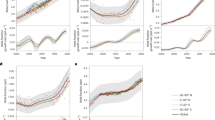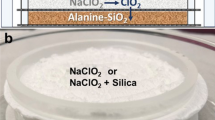Abstract
BECAUSE of their refractory nature, chlorofluorocarbons (CFCs) released by industries are eventually transported to the stratosphere, where they are slowly degraded by solar ultraviolet radiation into highly reactive chlorine atoms which can then participate in a catalytic ozone depletion cycle. For this reason, signatories to the Montreal Protocol and subsequent amendments have agreed to phase out the use of CFCs1 in the next few decades. Hydrofluorocarbons and hydrochlorofluorocarbons have been proposed as CFC replacements; atmospheric degradation of several of these is expected to produce trifluoroacetate (TFA), which is removed from the atmosphere mainly by rain2,3. The global average TFA concentration in rain water for the year 2010 is estimated4 to be 0.16 g r1-1—well below the concentrations thought to inhibit plant growth (~102-106g rI-1)5. But our modelling analysis, presented here, indicates that in conditions of high evapotranspiration, TFA could attain appreciable concentrations (>102 g I-1) in the local surface waters of seasonal wetlands within a few decades, if removal by degradation and seepage is limited.
This is a preview of subscription content, access via your institution
Access options
Subscribe to this journal
Receive 51 print issues and online access
$199.00 per year
only $3.90 per issue
Buy this article
- Purchase on Springer Link
- Instant access to full article PDF
Prices may be subject to local taxes which are calculated during checkout
Similar content being viewed by others
References
Parson, E. A. & Greene, O. Environment 37, 16–43 (1995).
Kanakidou, M., Dentener, F. J. & Crutzen, P. J. J. geophys. Res. (in the press).
Mogelberg, T. E., Nielsen, O. J., Sehested, J., Wallington, T. J. & Hurley, M. D. Chem. Phys. Lett. 226, 171–177 (1994).
Kotamarthi, V. R. et al. (abstr.) Eos 75, 137 (1994).
Thompson, R., Stewart, K. M. & Gillings, E. Report SP91-18.8 (Alternative Fluorocarbons Environmental Acceptability Study (AFEAS). Washington DC, 1994).
Scientific Assessment of Stratospheric Ozone: 1989 Global Ozone Research and Monitoring Project, Vol. II (Rep. No. 20, World Meteorological Organization, Geneva, 1989).
Proc.AFEAS Workshop on Decomposition of TFA in the Environment (ed. Magid, H.) (AFEAS, Washington DC, 1994).
Proc. Workshop on the Environmental Fate of Trifluoroacetic Acid (ed. Chumley, F. G.) (AFEAS, Miami Beach, 1994).
Groeneveld, A. H. C., de Kok, H. A. M. & van den Berg, G. Report CTR91-18.9 (AFEAS, Washington DC, 1993).
Groeneveld, A. H. C. & Berends, A. G. Report CTR91-18.20 (AFEAS, Washington DC, 1995).
Thompson, R. S. AFEAS Workshop on the Environmental Fate of Trifluoroacetic Acid (ed. Chumley, F. G.) Ch. 15 (AFEAS, Miami Beach, 1994).
Snyder, C. T. Int. Ass. Sci. Hydrol. 7, 53–59 (1962).
Hardie, L. A. & Eugster, H. P. Spec. Pap. Miner. Soc. Am. 3, 273–290 (1970).
Rosen, M. R. Spec. Pap. geol. Soc. Am. 289, 1–18 (1994).
Roble, S. M. Massachusetts Wildlife 1, 23–28 (1989).
Shortelle, A. B., Dudley, J. L., Prynoski, B. & Boyajian, M. Am. Wat. Resour. Ass. 28, 463–471 (1989).
Sefchick, J., Skorupa, J. & Schwarzbach, S. Rep. CTR91-18.6 (AFEAS, Washington DC, 1994).
Haan, C. T., Johnson, H. P. & Brakensiek, D. L. (eds) Hydrologic Modeling of Small Watersheds 3–293 (Monogr. no. 5, Am. Soc. Agricultural Engineers, St Joseph. MI, 1982).
Berner, R. A. Early Diagenesis: A Theoretical Approach (Princeton Univ. Press, 1980).
Tromp, T. K., Van Cappellen, P. & Key, R. M. Geochim. cosmochim. Acta 59, 1259–1283 (1995).
Eugster, H. P. & Jones, B. F. Am. J. Sci. 279, 609–631 (1979).
Zedler, P. H. Biological Rep. 85, U.S. Fish and Wildlife Service (US Dept Interior, Washington DC, 1987).
Visscher, P. T., Culbertson, C. W. & Oremland, R. S. Nature 369, 729–731 (1994).
Kotamarthi, V. R. et al. J. geophys. Res. (submitted).
Simmonds, P. G., Kerrin, S. L., Lovelock, J. E. & Shair, F. H. Atmos. Envir. 8, 209–216 (1974).
Singh, H. B., Salas, L., Shigeishi, H. & Crawford, A. Atmos. Envir. 11, 819–828 (1977).
Bastable, H. G., Rogers, D. P. & Schorran, D. E. Atmos. Envir. 24B, 137–151 (1990).
Sillman, S., Logan, J. A. & Wofsy, S. C. J. geophys. Res. 94, 1837–1851 (1990).
Satsumabayashi, H., Kurita, H., Chang, Y.-S., Carmichael, G. R. & Ueda, H. Atmos. Envir. 26A, 2835–2844 (1992).
Frank, H. AFEAS Workshop on the Environmental Fate of Trifluoroacetic Acid (ed. Chumley, F. G.) Ch. 4 (AFEAS, Miami Beach, 1994).
Franklin, J. Chemosphere 27, 1565–1601 (1993).
Palmer, E. & Newton, C. W. Atmospheric Circulation Systems (Academic, New York, 1969).
Author information
Authors and Affiliations
Rights and permissions
About this article
Cite this article
Tromp, T., Ko, M., Rodriguez, J. et al. Potential accumulation of a CFC-replacement degradation product in seasonal wetlands. Nature 376, 327–330 (1995). https://doi.org/10.1038/376327a0
Received:
Accepted:
Issue Date:
DOI: https://doi.org/10.1038/376327a0
This article is cited by
-
A gas chromatographic-mass spectrometric method for trace analysis of chlorofluorocarbons and their replacement compounds in atmospheric samples
Chromatographia (2000)
-
Environmental Trifluoroacetate
Nature (1996)
-
Two-dimensional modelling of some CFC replacement compounds
Journal of Atmospheric Chemistry (1996)
-
CFC alternatives under a cloud
Nature (1995)
Comments
By submitting a comment you agree to abide by our Terms and Community Guidelines. If you find something abusive or that does not comply with our terms or guidelines please flag it as inappropriate.



